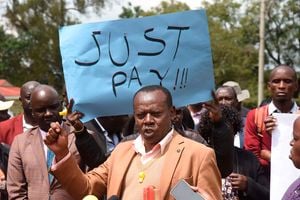
Meru
Premium
Meru town celebrates 110 years of glorious existence
Meru is preparing for a huge milestone that’s been 110 years in the making.
Located on the north-eastern slopes of Mount Kenya, the town is famous for its production of miraa and the ‘flying vehicles’ that transport the stimulant to the four corners of the nation.
On May 13, 1911, the first colonial District Commissioner Edward Butler Horne declared Meru a township due to its strategic importance to the British.

Over the past 110 years, Meru has played a crucial role in the nation’s development. From the fight for independence to the struggle for the Second Liberation, Meru heroes and heroines sacrificed their lives for a better Kenya.
Thus, this milestone is not just a celebration of a number, but a celebration of African resilience; where thousands of men and women on the slopes did duty for their land for more than a century to make it a shining light in the Horn of Africa.
Horne, popularly remembered by the Ameru as Kangaangi (the wanderer), declared one-square mile of the area around his first settlement (Pig & Whistle) as Meru township.
In the last century, Meru has undergone a major transformation from a market of iron-sheet buildings to a modern town of about 250,000 people.
It’s the seventh largest urban centre in the country and the county capital. The name of the region is derived from mieru – ‘quiet forests’ – and was coined by the Maasai in reference to the forested regions of Imenti and Tigania.
The town owes its roots to Mahomed Moti & Sons Ltd, an enterprise which started about a decade before Horne established the urban centre.

The shop, located next to the Nyayo monument on Njuri Ncheke Street, was founded by Indian immigrant Mohamed Moti, who started off with barter trade in the early 1900s.
Moti set up the town’s first shop at what is now known as Riverland on Horne’s request, who needed supplies for his staff. His business came to be named ‘Mahomed’ after colonial officials misspelled the name based on the proprietor’s Indian accent.
His grandson Majid Suleman says their family business has survived various historical events and major changes in the town.
“With the coming of the colonialists in 1908, my grandfather diversified into the sale of food stuff and building materials. He also ventured into milling, transport, mail delivery and expanded the business to the larger Meru, northern Kenya and north-eastern region,” says Suleman, noting that his grandfather’s water-powered flour mill still stands near Kathita River.
The business remained a monopoly for several years until about five other Indians joined them in the 1940s. The town got a major boost during the Second World War when British carrier corps set camp in Meru and northern Kenya.
“This is when my grandfather ventured into flour milling. He would supply the military with maize flour and fuel. Since the colonial officers frequented the shop for supplies, locals nicknamed it ‘Duka la Serikali’. He used to sell groceries, textiles, canned beef and biscuits which were preferred by the British. There was no much trade with the Meru people then,” offers the grandson.
Africanisation policy
After independence, the business had a downturn as the new government implemented the Africanisation policy.
“Most Hindus left but Muslims remained. We lost most of our businesses to the Africanisation policy despite being citizens. At this time, discrimination against the Asian community was commonplace. At one time, police wanted to deport me to India but they learned I was Kenyan,” he recalls.
The town was moved to the current location in the early 1950s and traders were ordered to leave the old town, now known as Riverland.
“The government had planned to have two streets starting from the highway all the way to Gakoromone market. The mosque was to be demolished. However, my father and other Muslims convinced the DC otherwise. The Njuri Ncheke Street was rerouted to save the mosque,” says Suleman.
He says the secret to the long survival of the family business is building trust with customers as well as the fact that its history is closely knit with that of the town.
Much has changed in the town, including access to essential services, building of infrastructure and trade.
“We now have piped water, electricity and good roads. But there is a need to expand the town’s capacity to accommodate the growing population and traffic. There is need for more engagement between the county government and business community to address new challenges,” says Suleman.
Municipality Manager Mbaabu Muguna says Meru has expanded over the decades from a colonial compound to a modern town that hosts major businesses and institutions.
“There are 14 universalities, 15 major health facilities, 23 banks, 11 co-operative societies, seven retail shops, 32 manufacturing companies, 27 star-rated hotels and vital national government agencies,” says Muguna.
To address the challenges brought about by the town’s rapid growth, the municipality board will establish more recreational spaces, including an arboretum near the upper Imenti Forest.
More emphasis has been placed on planning to stop the spread of informal settlements as well as manage traffic congestion. The county government has started paving pedestrian walkways and parking spaces.
“The national government is also expanding the sewerage facility,” says Muguna.
Meru Municipality now covers the area around Kiirua, along Meru-Nanyuki road, Ng’onyi, along Meru-Embu road, Thuura, along Meru-Mikinduri road, Mpuri, along Meru-Kithaku road and Kaithe along Meru-Maua road.





